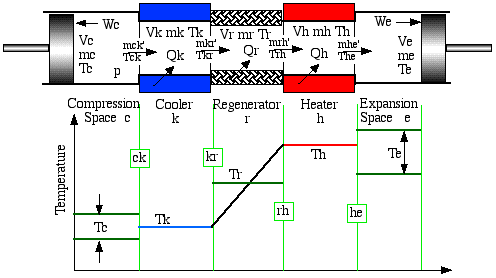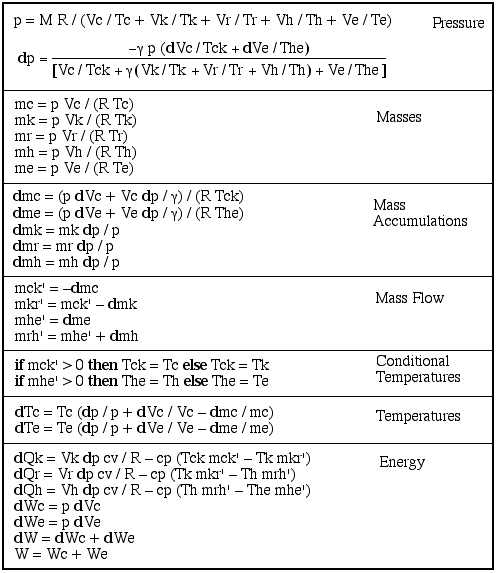function [vc,ve,dvc,dve] = volume(theta)
% determine working space volume variations and derivatives
% Israel Urieli, 7/6/2002
% Modified 2/14/2010 to include rockerV (rockvol)
% Modified 6/14/2016 to include beta free piston (sinevol)
% Argument: theta - current cycle angle [radians]
% Returned values:
% vc, ve - compression, expansion space volumes [m^3]
% dvc, dve - compression, expansion space volume derivatives
global engine_type % s)inusoidal, y)oke r)ockerV (all alpha engines)
if (strncmp(engine_type,'s',1))
[vc,ve,dvc,dve] = sinevol(theta);
elseif (strncmp(engine_type,'y',1))
[vc,ve,dvc,dve] = yokevol(theta);
elseif (strncmp(engine_type,'r',1))
[vc,ve,dvc,dve] = rockvol(theta);
elseif (strncmp(engine_type,'b',1))
[vc,ve,dvc,dve] = sinevol(theta);
end
%========================================================
function [vc,ve,dvc,dve] = sinevol(theta)
% sinusoidal drive volume variations and derivatives
% Israel Urieli, 7/6/2002
% Argument: theta - current cycle angle [radians]
% Returned values:
% vc, ve - compression, expansion space volumes [m^3]
% dvc, dve - compression, expansion space volume derivatives
global vclc vcle % compression,expansion clearence vols [m^3]
global vswc vswe % compression, expansion swept volumes [m^3]
global alpha % phase angle advance of expansion space [radians]
vc = vclc + 0.5*vswc*(1 + cos(theta+pi));
ve = vcle + 0.5*vswe*(1 + cos(theta + alpha+pi));
dvc = -0.5*vswc*sin(theta+pi);
dve = -0.5*vswe*sin(theta + alpha+pi);
%========================================================
function [vc,ve,dvc,dve] = yokevol(theta)
% Ross yoke drive volume variations and derivatives
% Israel Urieli, 7/6/2002
% Argument: theta - current cycle angle [radians]
% Returned values:
% vc, ve - compression, expansion space volumes [m^3]
% dvc, dve - compression, expansion space volume derivatives
global vclc vcle % compression,expansion clearence vols [m^3]
global vswc vswe % compression, expansion swept volumes [m^3]
global alpha % phase angle advance of expansion space [radians]
global b1 % Ross yoke length (1/2 yoke base) [m]
global b2 % Ross yoke height [m]
global crank % crank radius [m]
global dcomp dexp % diameter of compression/expansion pistons [m]
global acomp aexp % area of compression/expansion pistons [m^2]
global ymin % minimum yoke vertical displacement [m]
sinth = sin(theta);
costh = cos(theta);
bth = (b1^2 - (crank*costh)^2)^0.5;
ye = crank*(sinth + (b2/b1)*costh) + bth;
yc = crank*(sinth - (b2/b1)*costh) + bth;
ve = vcle + aexp*(ye - ymin);
vc = vclc + acomp*(yc - ymin);
dvc = acomp*crank*(costh + (b2/b1)*sinth + crank*sinth*costh/bth);
dve = aexp*crank*(costh - (b2/b1)*sinth + crank*sinth*costh/bth);
%========================================================
function [vc,ve,dvc,dve] = rockvol(theta)
% Ross Rocker-V drive volume variations and derivatives
% Israel Urieli, 7/6/2002 & Martine Long 2/25/2005
% Argument: theta - current cycle angle [radians]
% Returned values:
% vc, ve - compression, expansion space volumes [m^3]
% dvc, dve - compression, expansion space volume derivatives
global vclc vcle % compression,expansion clearence vols [m^3]
global crank % crank radius [m]
global acomp aexp % area of compression/expansion pistons [m^2]
global conrodc conrode % length of comp/exp piston connecting rods [m]
global ycmax yemax % maximum comp/exp piston vertical displacement [m]
sinth = sin(theta);
costh = cos(theta);
beth = (conrode^2 - (crank*costh)^2)^0.5;
bcth = (conrodc^2 - (crank*sinth)^2)^0.5;
ye = beth - crank*sinth;
yc = bcth + crank*costh;
ve = vcle + aexp*(yemax - ye);
vc = vclc + acomp*(ycmax - yc);
dvc = acomp*crank*sinth*(crank*costh/bcth + 1);
dve = -aexp*crank*costh*(crank*sinth/beth - 1);
|

